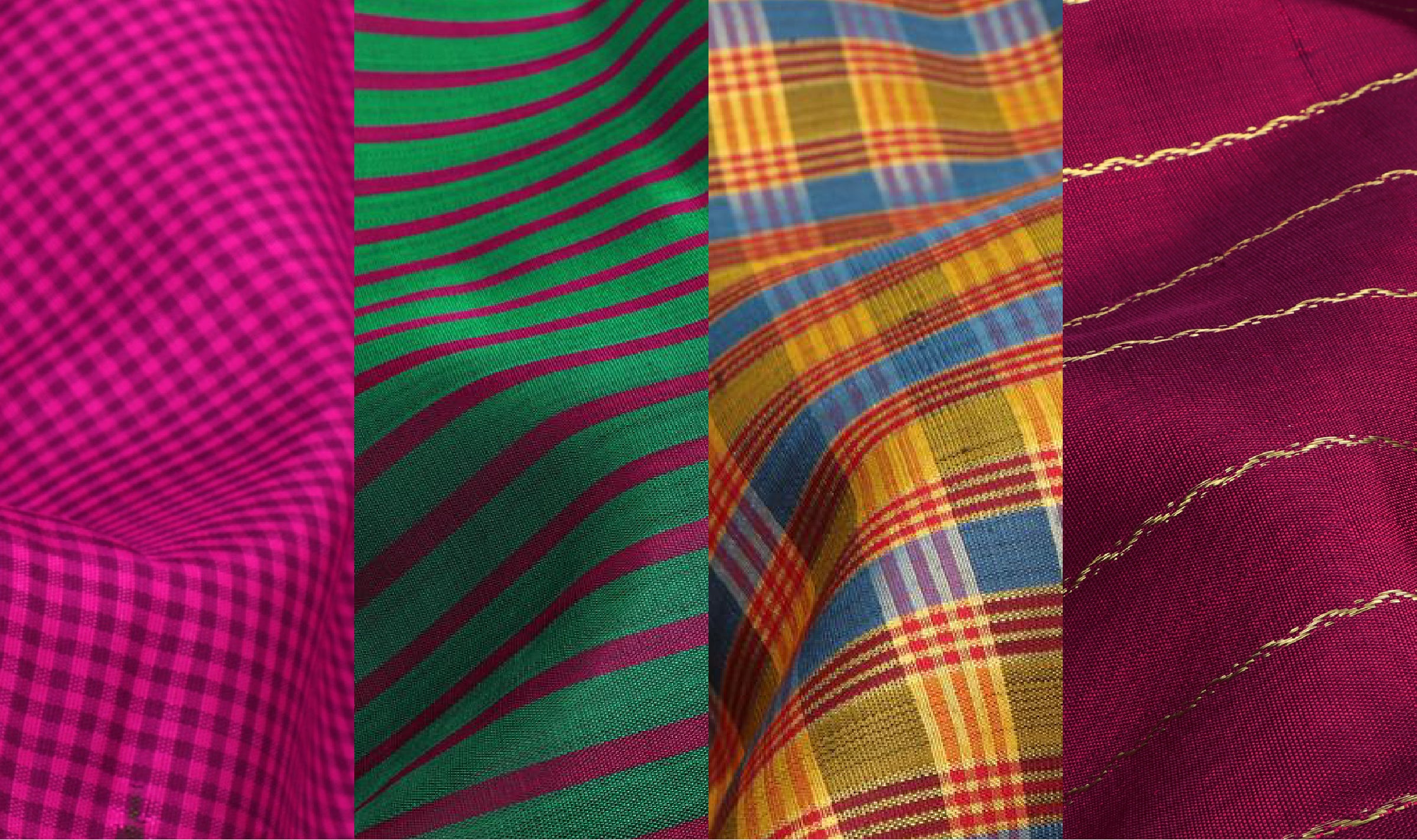Varna Sutra : Samyukta - The intrinsic Union

The kanjivaram sari is known for its bold geometry which emerges from its colour language as well as from its distinctive structure and layout. The weavers of Kanchipuram employ varied complex and laborious weave techniques that allow a range of colour permutations to the warp and weft, while lending the queen of silks its signature drama.
Structure plays an important role in form and design in the Tamil heartland, most visible in the symmetry and balance of the pulli kolam drawn outside homes in South India. The starting point for this design is a dotted grid which is mapped out as a foundation upon which to develop the kolam pattern.
The centrality of structure is also reflected in the grammar of Sangam literature as it defines geographical landscapes—kurinjifor mountains, mullai for the forest, marutham for cropland, neithal for the seashore and palai for the desert. In the quietly lyrical and deeply expressive poems of the Sangam tradition, every landscape is closely tied with an emotion, and every form plays a role in telling a story. Similarly, the very foundation of the kanjivaram—its anatomy and layout—gives rise to the expression of colour and motif on the silk.
Structurally, the designs and techniques used to define the borders and pallus of a kanjivaram sari form the basis of its anatomy. Skilled techniques are used to weave the classic korvai borders that are a hallmark of the kanjivaram craft, as well as to attach benth or pethni pallus to the body of the sari to enhance its geometry.
While the kanjivaram’s woven motifs and patterns are much admired, it is the sari’s fundamental anatomy that form the foundation for its ornamentation. The inherent colour and structural geometry of the drape lends itself to intricate and dramatic embellishment; creating a canvas for woven accents. In this edition of Varna Sutra, we will look at three elements of the kanjivaram’s anatomy.
Structure in Weave
Among the key techniques of the kanjivaram are the methods of joining borders, in korvai, and pallus, in benth or pethni, to the body of the sari. All three forms rely on meticulous yarn jointing and result in striking and bold layouts of the drape.

To understand what these beautiful skill sets can do to colour and weave, imagine drawing a line in red, and then wanting to continue the line, in, let’s say, black. To do this we’d have to switch from the red ink to black. Both the korvai as well as the pethni and benth techniques are much the same, except instead of swapping out a pen, or ink, a very careful ‘interlock’ is created between where the weaver wants to stop the red colour and start the black colour. Let’s not forget that a few thousand yarn ends sit side by side on a sari, so think about the patience and skill required in doing this, and by hand.
Benth

The benth technique is used in a kanjivaram whose body and pallu are woven in different hues. In this process, a single stretch of warp yarn is dyed in two different colours. On the loom, a weave interlock is used to even out the visible section of the yarn where the shades spill over into one another, at the intersection of the body and the pallu. The reverse side of a sari woven in benth will reveal both the shades of the body and that of the pallu.
Pethni

In the pethni technique, the warp of the body is different from that of the pallu, and the two are interlocked in a complex and laborious process requiring great skill. The interlock is visible on the reverse side of the sari, where the threads of the body colour appear towards the pallu and the pallu threads are seen closer to the body. The pethni is also used in tissue kanjivarams that feature zari in the body but only thread work on the pallu. Zari and thread have different tensions, making this a particularly painstaking and time-consuming process. The pethni is an increasingly rare technique. This is also why, for example, a kanjivaram that has the zari designs from the body continuing into the pallu might cost less than one with no zari on the pallu at all. The price point of a kanjivaram reflects not only the materials but also the skill that goes into it.
Korvai

The handwoven attachment of korvai borders is one of the hallmarks of a kanjivaram. Intricate in execution, these jointed border attachments enhance the kanjivaram’s bold use of colour, creating solid and textured borders that emphasise high contrast to the warp and weft that run through the body. The korvai technique is a weaving detail that becomes a design feature in itself, an example of form following function. The detail takes on a multitude of forms, from simple temple designs and modern straight line interlocks, to complex puliyar moggu and thazhampu reku, celebrating contrasts of colour and pattern on the sumptuous silken drape.
The extraordinary weavers of Kanchipuram hand down their skill from one generation to the next, passing on the knowledge of complex weave techniques that give the kanjivaram its distinctive structure. The anatomy of the weave forms the basis of the craft, further enhanced by the complex interplay of colours and the intricate shapes and motifs that adorn the drape.
- For The Kanakavalli Journal, by Aneesha Bangera.



